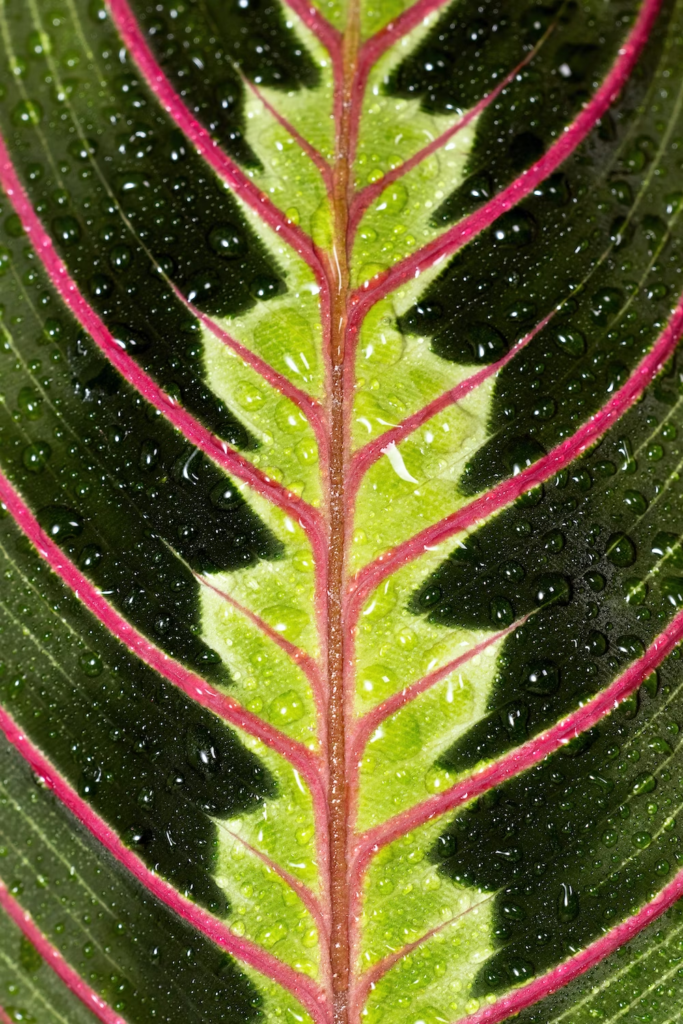Calatheas and their diseases can be quite demanding, especially if you have a rare variety that is difficult to maintain.

If you have encountered any problems with your Calathea, causing it to look droopy compared to when you bought it, review this list to find the cause and apply the relevant solution.
Contents
Next, we will explore 10 Calathea diseases and their possible remedies:
Calathea: Diseases
The most common diseases of Calathea are the following.
1. Withering
The main causes of Calatheas wilting are insufficient or excessive watering. This is common and has several reasons. Most of them are fortunately quite easy to fix.
The most likely cause is insufficient watering. Plant cells are composed primarily of water, filling space and allowing them to maintain their structure. When there is not enough water to fill the cells, the leaves lose their vertical structure and begin to wilt.

Watering the soil deeply or from below until the soil is replenished again is a very effective solution.
By the way, be sure to check the soil before watering, as this may be another cause that watering won’t fix. If the top layer of soil is still wet, the problem may actually be overwatering.
In that case, let the soil dry out completely or, if the problem is severe, replant in fresh soil to save the rotting roots.
2. Rolled leaves
Calatheas curl their leaves to protect themselves when conditions are potentially dangerous. Although curled leaves on Calatheas may appear more severe than wilted leaves, the causes are largely very similar. The main culprit, again, is insufficient watering.
Dehydrated plants will begin to wilt, eventually curling inward to retain as much moisture in the leaves as possible. Another humidity issue, lack of humidity, may also be the cause.
We have an article dedicated to how to heal a Calathea with diseases: brown, dry and curled leaves, etc. Check it out for details on these specific types of conditions.
3. Yellow leaves
The most common causes of yellowing Calathea leaves are pest-related diseases, lack of light, and excessive watering.
There are many reasons why your Calathea may be turning yellow , however, the most common and likely problem is overwatering.
Calatheas like moist soil, but not waterlogged. This prevents oxygen from reaching the roots and encourages the growth of fungi that cause rotting of the roots and stems. Once this happens, plants cannot absorb the nutrients necessary to function, causing the leaves to turn yellow as a result of stress.
Allow the soil to dry slightly, and if the problem does not resolve, replant as soon as possible to remove soil and rotted roots. Cut out infected areas and plant in new soil and a new pot to recover.
Other Calathea problems to watch out for include:
- insufficient watering
- Overpaid
- Low humidity
- Pest problems
- Transplant shock
- Sudden changes in the environment
A little yellowing on the underside of the plant is nothing to worry about. Older leaves will turn yellow, brown, and eventually fall from the plant. As long as there are only a couple of leaves and new ones keep appearing, everything is fine.
4. Brown edges
If you notice Calathea leaves turning brown at the edges, it is most likely a moisture problem.
Calathea leaves can be quite sensitive, depending on the variety you have chosen. If conditions aren’t right, you may encounter one of the most common Calathea diseases: leaves turning brown at the edges.

The first problem to consider is a humidity problem. Both underwatering and lack of moisture can cause the edges of leaves to dry out and turn brown. This usually starts at the tips and slowly spreads to the rest of the blade if the problem is not resolved.
If you water regularly, the other concern could be the quality of the water you are using. Calatheas are sensitive to chemicals in some tap water, leading to lime buildup in the soil, which causes the leaves to turn brown. Salt buildup from overfeeding can also cause the same problem.
In these cases, rinse the soil with filtered water until it runs clear. Water with filtered water in the future and do not fertilize for a couple of months to allow the plant to recover.
5. Yellow and brown spots
The appearance of yellow and brown spots on Calathea leaves are a sure sign of a pest problem.
Several sap-sucking pests feed on the juicy leaves of Calathea plants. This damages the internal structures of the plant and disrupts its growth, causing parts of the leaves to turn yellow and then brown as they die.
The first response to a pest problem should be to isolate the plant. Move the diseased Calathea to an isolated location away from other plants to prevent spread. Next, treat with insecticidal soap or horticultural oil to eliminate insects, using repeated applications at recommended intervals until all pests have been eliminated.
6. Soft stems
As you already know, overwatering Calatheas can cause root rot.
Calathea is very sensitive to excessive watering. They hate being in soggy soil, which leads to root rot beneath the soil. This problem can spread above ground, causing stem rot. The lack of a sturdy structure will also cause the stems to droop and the leaves to wilt.

Root rot is a serious problem that requires immediate attention. Once the stems have become soft, it is likely that a large number of roots are rotting beneath the soil . You will need to replant as soon as possible, completely replacing the soil to eliminate any fungus around the roots.
Prune out any rotted areas to prevent spread and repot in a new pot with plenty of drainage holes.
7. Dull color
The main cause of Calathea leaf discoloration problems is excessive exposure to direct sun. The main reason for color problems in Calatheas is sunlight, specifically, when there is too much of it.
Calatheas are used to bright indirect light, not the sun’s rays. If placed in the path of direct sunlight during the hottest parts of the day, the leaves will likely turn pale from damage.

Be sure to move the plant out of direct sun immediately, or cover your window with a sheer curtain to filter out the sun’s rays. Aim for bright but indirect light for the best possible performance.
8. Bugs around the ground
Calathea with diseases is sometimes found in low light areas , where the soil remains wet for a long time , attracting all kinds of unwanted bugs. These are not welcome in our homes, and even less so in our houseplants.
If evaporation is low and the soil remains moist, you are likely to attract one of the most annoying indoor pests: the mold fly, also known as the fungus gnat.

They are quite difficult to remove. If you try to spray them with insecticidal soap or horticultural oil, they will simply fly away from the leaves, returning when all danger has passed.
To get rid of fungus gnat problems, you’ll need to try a few things:
- First, place sticky traps in the soil around your plants to catch as many flying insects as possible.
- Also consider repotting to eliminate any eggs or insects hiding in the soil.
- Use a soil solution irrigation to combat fungus gnats, although this can affect growth if not used carefully.
9. Mealybugs
You’ll identify them by a white, fluffy coating on the leaf that the mealybugs leave behind. Mealybugs are common pests that cause disease on Calathea and feed on its leaves.
These sap-sucking insects are small but easy to identify by the white substance they use . White dust around the leaves and stems is a sure sign of mealybug.

Wash away any visible insects , making sure to check the undersides of the leaves where they like to hide. Next, apply insecticidal soap or horticultural oil to all the leaves.
You may need to repeat the process several times until you are sure that all the mealybugs are gone. Otherwise, they will reproduce quickly and could come back even stronger.
10. Mites
Small cobwebs between leaves and stems indicate a common pest problem: mites. These insects are incredibly small, difficult to see with the naked eye, but easy to identify by their webs. Look in areas where there are nearby stems and leaves and little air flow, and you may see them gathered there.
Again, isolate the plant and treat as many times as necessary to eliminate the problem.
Conclusion
Calathea can be finicky, depending on the species you have. However, the problems you encounter are generally not impossible to solve. In fact, most can be easily reversed. Use this list to save your Calathea from diseases!
